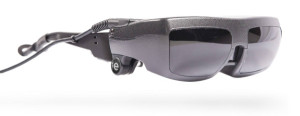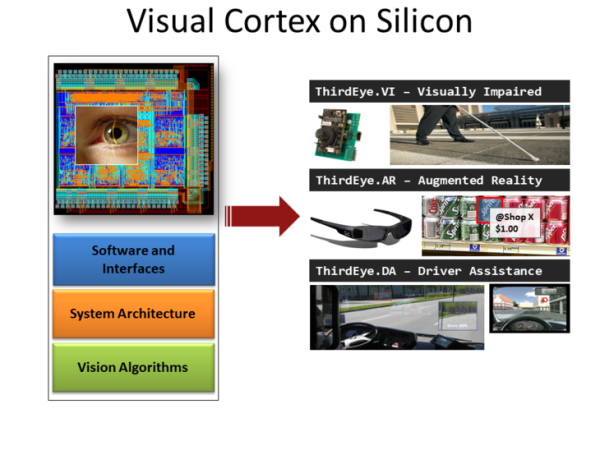It is estimated that 285 million individuals are affected by some form of visual impairment globally. Among this population, 246 million have low vision and 39 million are blind. Visual impairments date back to primitive times, and for centuries scientists and medical professionals have sought cures. Though there is yet to be a cure-all, recent advanced technologies such as the eSight and the Visual Cortex on Silicon hint at a promising future.
General Facts
According to the National Federation of the Blind, there are several ways to define blindness:
- Many people regard blindness as the inability to see at all or, at best, to discern light from dark.
- The National Federation of the Blind encourages persons to consider themselves to be blind if their sight is bad enough—even with corrective lenses—that they must use alternative methods to engage in any activity that persons with “normal” vision would do using their eyes.
- The United States Bureau of the Census’ question about “significant vision loss” encompasses both total or near-total blindness and “trouble seeing, even when wearing glasses or contact lenses.”
- The statutory definition of “legally blind” is that central visual acuity must be 20/200 or less in the better eye with the best possible correction or that the visual field must be 20 degrees or less.
- There are generally no accepted definitions for “visually impaired,” “low vision,” or “vision loss.”
Assistive Technology and Visual Impairments
Assistive technology has been around now for decades and helps remove several barriers to education and employment for visually impaired individuals. For example, with advancements in technology:
- Students with visual impairments can complete homework, do research, take tests, and read books along with their sighted classmates.
- Adults with visual impairments can continue to work and pursue a tremendous range of careers because of the use of computers and other devices.
Technology giving ‘sight’ to visually impaired
As briefly mentioned above, there are two technologies that offer promising solutions for individuals with visual impairments.
eSight
As stated in the statistic above, low vision affects millions of people. There are several available  solutions to help these individuals accomplish daily tasks, however none of these grant the legally blind the ability to see.
solutions to help these individuals accomplish daily tasks, however none of these grant the legally blind the ability to see.
The creators behind a newer technology called eSight aim to give these individuals their sight. You may be asking what exactly eSight is as well as how it works. In short, they are electronic glasses that enable the legally blind to actually see. According to the eSight website:
“Unlike other low-vision aids, eSight is designed to enable the freedom, self-efficacy, and confidence only possible by enabling seamless vision, regardless of circumstance and setting. eSight is worn hands-free and, for many people, all day, allowing people with low-vision to accomplish the tasks they choose, without barriers of access.”
How it works
eSight uses a combination of advanced technologies to provide the “very best” in vision enhancement, including a sophisticated high-speed camera, patented video processing software, a computer processor and the highest quality video OLED screens. eSight consists of a headset, special prescription lens frames, and a controller. The controller allows the wearer to customize zoom, contrast and color settings, giving them the ability to see near, far, and mid-range tasks.
With eSight, individuals who are legally blind can see most things that normally sighted people see such as:
- Newspapers, books, menus, signs, and other reading materials from any distance
- Computers and other work-related tools
- TV and movies
- Concerts, plays, and other live events
- Faces from up close and from a distance
Visual Cortex on Silicon Project
Picking something up at a grocery store may seem simple to most, but for individuals with visual impairments, this task is anything but simple. In the excerpt below stating a common situation, it becomes apparent that we rely heavily on our sense of sight while we’re shopping.
“Standing in the grocery store, you scan the peanut butter jars looking for the one on your list. Your eyes flit from label to label until they land on the familiar red, blue and green jar, and you reach to pick it up and place it in your cart. Then, it’s on to the next item on your list.”
To help make shopping easier for the visually impaired, Jack Carroll–a distinguished professor in the College of Information Sciences and Technology (IST) at Penn State–has completed a study that explored how smart cameras could eventually guide visually impaired shoppers to the items they need. Carroll said on the project, “This is one of the biggest computing projects Penn State’s been involved with. I’ve been working with what we do with the technology after the camera is available, specifically in a shopping scenario. Shopping is so universal and it signifies normalcy–it’s important that the visually impaired be able to do it, too.”
The project is dubbed the Visual Cortex on Silicon, and is led by Penn State Computer Science and Engineering Distinguished professor Vijaykrishnan Narayanan, and Penn State is the lead university alongside seven other universities. (Other universities include: MIT, University of Southern California, UCLA, University of California San Diego, Pittsburgh University, Stanford University and York College.) The project is funded by a $10 million National Science Foundation fund that’s seeking to replicate the human vision system using information technology. The project is funded through September 2018.
According to an article on the Penn State website:
“The project aims to create sophisticated ‘smart’ cameras that will replace or even surpass the abilities of the human vision system, which can interpret complex scenes and complete complicated tasks while using less than 20 watts of power. The cameras will be used in mobile devices, such as smartphones, so energy efficiency is key to fitting a complex system into a small piece of hardware.”
To learn more about this project, visit the Visual Cortex on Silicon expedition page.


